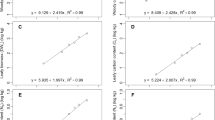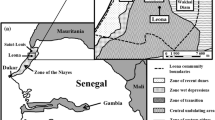Abstract
Pastures store over 90% of their carbon and nitrogen below-ground as soil organic matter. In contrast, temperate conifer forests often store large amounts of organic matter above-ground in woody plant tissue and fibrous litter. Silvopastures, which combine managed pastures with forest trees, should accrete more carbon and nitrogen than pastures or timber plantations because they may produce more total annual biomass and have both forest and grassland nutrient cycling patterns active. This hypothesis was investigated by conducting carbon and nitrogen inventories on three replications of 11 year-old Douglas-fir (Pseudotsuga menziesii)/perennial ryegrass (Lolium perenne)/subclover (Trifolium subterraneum) agroforests, ryegrasss/subclover pastures, and Douglas-fir timber plantations near Corvallis, Oregon in August 2000. Over the 11 years since planting, agroforests accumulated approximately 740 kg ha–1 year –1 more C than forests and 520 kg ha–1 year–1 more C than pastures. Agroforests stored approximately 12% of C and 2% of N aboveground compared to 9% of C and 1% of N above ground in plantations and less than 1% of N and C aboveground in pastures. Total N content of agroforests and pastures, both of which included a nitrogen-fixing legume, were approximately 530 and 1200 kg ha–1 greater than plantations, respectively. These results support the proposition that agroforests, such as silvopastures, may be more efficient at accreting C than plantations or pasture monocultures. However, pastures may accrete more N than agroforests or plantations. This apparent separation of response in obviously interrelated agroecosystem processes, points out the difficulty in using forest plantation or pasture research results to predict outcomes for mixed systems such as agroforests.
Similar content being viewed by others
References
Adger W.N., Brown K., Shiel R.S. and Whitby M.C. 1992. Carbon dynamics of land use in Great Britain. Journal of Environmental Management 36: 117–133.
Alban D.H. 1982. Effects of nutrient accumulation by aspen, spruce, and pine on soil properties. Soil Science Society of America Journal. 46: 853–861.
Cambardella C. and Elliott E. 1994. Carbon and nitrogen dynamics of soil organic matter fractions from cultivated grassland soils. Soil Science Society of America Journal. 58: 122–130.
Cathcart J.F. 2000. Carbon sequestration: A working example from Oregon. Journal of Forestry 98: 32–37.
Corre M.D., Schnabel R.R. and Shaffer J.A. 2000. Evaluation of soil organic carbon under forests, cool-season grasses and warm-season grasses in the northeastern U.S. Soil Biology and Biochemistry 31: 1531–1539.
Cropper W.P. and Ewel K.C. 1984. Carbon storage patterns in Douglas-fir ecosystems. Canadian Journal of Forest Research 14: 855–859.
Davidson E. and Ackerman I. 1993. Changes in soil carbon inventories following cultivation of previously untilled soils. Biogeochemistry 20: 161–193.
Dear B.S., Cocks P.S., Peoples M.B., Swan A.D. and Smith A.B. 1999. Nitrogen fixation by subterranean clover (Trifolium subterraneum L.) Growing in pure culture and in mixtures with varying densities of lucern (Medicage sativa L.) or phalaris (Phalaris aquatica L.). Australian Journal of Agricultural Research 50: 1047–1058.
de Groot P. 1990. Are we missing the grass for the trees? New Scientist 125: 29–30.
Gholz H.L., Grier C.C., Campbell A.G. and Brown A.T. 1979. Equations for estimating biomass and leaf area of plants in the pacific northwest, Forest Research Lab Research Paper 41. Oregon State University, Corvallis, Oregon, USA, 40 p.
Houghton R.A. and Hackler J.L. 2000. Changes in terrestrial carbon storage in the United States. 1. The roles of agriculture and forestry. Global Ecology and Biogeography 9: 125–144.
Johnson D.W. 1992. Effects of forest management on soil carbon storage. Water Air and Soil Pollution 64: 83–120.
Kaur B., Gupta S.R. and Singh G. 2000. Soil carbon, microbial activity and nitrogen availability in agroforestry systems on moderately alkaline soils in northern India. Applied Soil Ecology 15: 283–294.
Lugo A.E. and Brown S. 1993. Management of tropical soils as sinks or sources of atmospheric carbon. Plant and Soil 149: 27–41.
Maikhuri R.K., Semwal R.L., Rao K.S., Singh K., and Saxena K.G. 2000. Growth and ecological impacts of traditional agroforestry tree species in Central Himalaya, India. Agroforestry Systems 48: 257–272.
Motazedian I. 1984. Effects of defoliation treatments on forage quality, quantity, and species composition of a Lolium perenne (L.)-Trifolium subterraneum (L.) Pasture. M.S. Thesis, Oregon State University, Corvallis, Oregon, USA. 152p.
Potter K.N., Torbert H.A., Johnson H.B. and Tischler C.R. 1999. Carbon storage after long-term grass establishment on degraded soils. Soil Science 164: 718–725.
Sharrow S.H. 1992. Tree planting pattern effects on forage production in a Douglas-fir agroforest. Agroforestry Systems 16: 167–175.
Sharrow S.H. and Tober D.A. 1979. A simple lightweight point frame. Journal of Range Management 32: 75–76.
Sharrow S.H., Carlson D.H., Emmingham W.H. and Lavender D. 1996. Productivity of two Douglas-fir/subclover/sheep agroforests compared to pasture and forest monocultures. Agroforestry Systems 34: 305–313.
Smith K.A. and Frost J.P. 2000. Nitrogen excretion by farm livestock with respect to land spreading requirements and controlling nitrogen losses to ground and surface waters. Part 1: cattle and sheep. Bioresource Technology 71: 173–181.
Steel R.G.D. and Torrie J.H. 1980. Principles and procedures of statistics. McGraw-Hill Book Company, New York, New York, USA, 633 pp.
Swisher J. and Masters G. 1992. A mechanism to reconcile equity and efficiency in global climate protection: international carbon emission offsets. Ambio 21: 154–159.
Taylor J.A. and Lloyd J. 1992. Sources and sinks of atmospheric CO2. Australian Journal of Botany 40: 407–418.
Thuille A., Buchmann N. and Schulze E.D. 2000. Carbon stocks and soil respiration rates during deforestation, grassland use and subsequent Norway spruce afforestation in the Southern Alps, Italy. Tree Physiology 20: 849–857.
Author information
Authors and Affiliations
Corresponding author
Rights and permissions
About this article
Cite this article
Sharrow, S., Ismail, S. Carbon and nitrogen storage in agroforests, tree plantations, and pastures in western Oregon, USA. Agroforestry Systems 60, 123–130 (2004). https://doi.org/10.1023/B:AGFO.0000013267.87896.41
Issue Date:
DOI: https://doi.org/10.1023/B:AGFO.0000013267.87896.41




